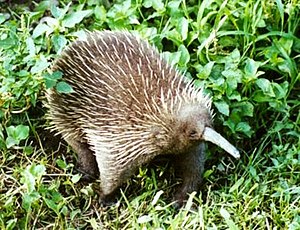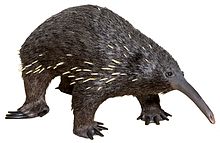Long-billed hedgehog
| Long-billed hedgehog | ||||||||||||
|---|---|---|---|---|---|---|---|---|---|---|---|---|

Western long-billed hedgehog ( Zaglossus bruijni ) |
||||||||||||
| Systematics | ||||||||||||
|
||||||||||||
| Scientific name | ||||||||||||
| Zaglossus | ||||||||||||
| Gill , 1877 |
The long-billed urchins , also long-billed ant urchins ( Zaglossus ), are a genus of egg-laying mammals from the family of the ant urchins (Tachyglossidae). The number of species is unclear; today we usually assume three recent species.
description


Long-billed hedgehogs reach a head body length of 45 to 77 centimeters and a weight of 5 to 16 kilograms. The shoulder height is 40 cm. The fourth and fifth claws on the front and rear feet are partially receded, a characteristic feature by which the three species can be easily distinguished. In contrast to the short-billed hedgehog , their spines are shorter, sparser and partially hidden in their fur. In addition, long-billed hedgehogs are long-legged. The tubular snout is also longer and clearly curved downwards; she has an excellent sense of smell. The auricles are small. The fur is brown or black.
Distribution and way of life
Long-billed hedgehogs are endemic to New Guinea , where they mainly inhabit forest areas, but can also be found in high mountain areas up to 4000 meters above sea level. These animals are crepuscular or nocturnal and live solitary outside of the mating season. Their diet consists primarily of earthworms , which they ingest with their long, sticky tongues, with small barbs on their tongue helping them. About a month after mating, a 17 mm egg is placed in the brood pouch. The young hatch about a week later and remain in the pouch for about ten days. After another ten days, the youngster leaves the bag and is in a nest for the next few weeks; the mother continues to look after her offspring during this time. The highest age ever reached by a long-billed hedgehog in captivity was 31 years; no figures are available for the wild.
threat
Their habitat is increasingly restricted by clearing forests. In addition, the meat of the long-billed hedgehog is considered a delicacy. Specially trained dogs hunt the animals and bring them down. The International Union for Conservation of Nature lists them as threatened ( endangered ).
Systematics
The long- billed urchin , together with the short-billed urchin living in Australia, form the family of the ant urchins . The number of species of long-billed hedgehog is unclear. In the past several species were assumed, later all of them were combined into one species, the long-billed hedgehog ( Zaglossus bruijni ). Today a distinction is made between three recent and two only fossil-known species:
- Barton's long-billed hedgehog ( Zaglossus bartoni )
- Western long-billed hedgehog ( Zaglossus brujini )
- Attenborough long-billed hedgehog ( Zaglossus attenboroughi ).
- † Zaglossus hacketti (Western Australia, extinct about 15,000 years ago. Length about 1 meter, only a few bones found)
- † Zaglossus robustus ( Tasmania in the Pleistocene , known from a fossil skull, probably approx. 65 cm long)
For detailed information, see Echidna .
literature
- Ronald M. Nowak: Walker's Mammals of the World. 6th edition. Johns Hopkins University Press, Baltimore, 1999, ISBN 0801857899
- Tim F. Flannery and Colin P. Groves: A revision of the genus Zaglossus (Monotremata, Tachyglossidae), with description of new species and subspecies . Mammalia 62 (3): 367–396, 1998, online version ( Memento from May 15, 2013 in the Internet Archive ) (PDF, English; 1.8 MB)